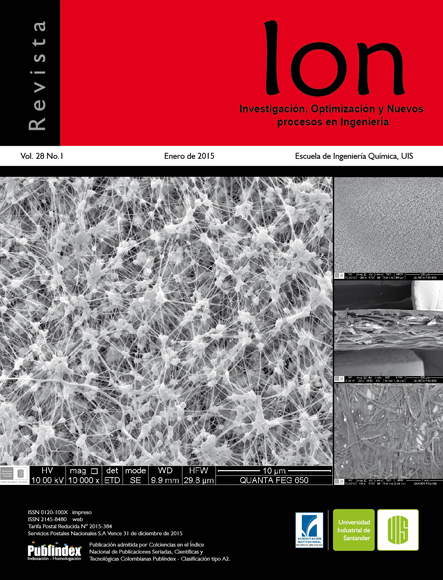Adsorption kinetics of Cr (VI) using chemically modified residual biomass in batch and continuous systems
Published 2015-07-17
Keywords
- Adsorption,
- Citric Acid,
- Hexavalent Chromium;,
- Residual Biomass.
How to Cite
Abstract
It was studied the adsorption of Cr (VI) from lignocellulosic residual biomass: bagasse palm and yam peels. Also, it was studied a modification with citric acid into biomasses to improve the efficiency of metal adsorption. Determinating this metal in solution was performed using the colorimetric method 1,5 diphenylcarbazide. From FTIR analysis and characterization adsorbents before and after the process of removal of Cr (VI) was found that hydroxyl and carbonyl groups contribution to take up this process. Modification into biomasses accord to Langmuir isotherm improves the adsorption efficiency. It was improved from 13 to 41 mg/g for bagasse palm, and from 22 to 26 mg/g for yam peels. In continuous systems, this process was improved. Optimal condition to remove this metal was determined in pH 2 and particle size of 1mm for both biomasses. It is also the Elovich kinetic the best model to describe the adsorption process.
Downloads
References
[2] Jung C, Heo J, Han J, Her N, Lee S-J, Ohd J, Ryu J, Yoon Y. Hexavalent chromium removal by various adsorbents: Powdered activated carbon, chitosan, and single/multi-walled carbon nanotubes. Separation and Purification Technology. 2013;106:63–71.
[3] Pandey S, Mishra SB. Organic–inorganic hybrid of chitosan/organoclay bionanocomposites for hexavalent chromium uptake. Journal Colloid Interface Science. 2011;361:509–20.
[4] Khezami L, Capart R. Removal of chromium(VI) from aqueous solution by activated carbons: kinetic and equilibrium studies. Journal of Hazard Material. 2005;123:223–31.
[5] Shrestha RM, Varga I, Bajtai J, Varga M. Design of surface functionalization of waste material originated charcoals by an optimized chemical carbonization for the purpose of heavy metal removal from industrial waste waters. Microchemical Journal. 2013;108:224–32.
[6] Torab-Mostaedi M, Asadollahzadeh M, Hemmati A, Khosravi A. Equilibrium, kinetic, and thermodynamic studies for biosorption of cadmium and nickel on grapefruit peel. Journal of the Taiwan Institute of Chemical Engineers. 2013;44:295–302.
[7] Ning-chuan F, Xue-yi G. Characterization of adsorptive capacity and mechanisms on adsorption of copper, lead and zinc by modified orange peel. Transactions Nonferrous Metals Society of China. 2012;22:1224–31.
[8] Lasheen MR, Ammar NS, Ibrahim HS. Adsorption/desorption of Cd(II), Cu(II) and Pb(II) using chemically modified orange peel: Equilibrium and kinetic studies. Solid State Sciences. 2012;14:202–10.
[9] Momčilović M, Purenović M, Bojić A, Zarubica A, Ranđelović M. Removal of lead (II) ions from aqueous solutions by adsorption onto pine cone activated carbon. Desalination. 2011;276:53–9.
[10] Ismaiel AA, Aroua MK, Yusoff R. Palm shell activated carbon impregnated with task-specific ionic-liquids as a novel adsorbent for the removal of mercury from contaminated water. Chemical Engineering Journal. 2013;225:306–14.
[11] Hamza IAA, Martincigh BS, Ngila JC, Nyamori VO. Adsorption studies of aqueous Pb(II) onto a sugarcane bagasse/multi-walled carbon nanotube composite. Physics and Chemistry of the Earth. 2013;66:157–66.[
12] Altun T, Pehlivan E. Removal of Cr(VI) from aqueous solutions by modified walnut shells. Food Chemistry. 2012;132:693–700.
[13] Pinzón-Bedoya ML, Vera-Villamizar LE. Modelamiento de la cinética de bioadsorción de Cr (iii) usando cáscara de naranja. Dyna. 2009;76(160):95-106.
[14] AOAC international (2014). Program quick reference guide. Disponible desde internet en: http://www.aoac.org/iMIS15_Prod/AOAC. Consultado el 10 de enero de 2014.
[15] Pitsari S, Tsoufakis E, Loizidou M. Enhanced lead adsorption by unbleached newspaper pulp modified. Chemical Engineering Journal. 2013;223:18–30.
[16] Romera E, González F, Ballester A, Blázquez ML, Muñoz JA. Comparative study of biosorption of heavy metals using different types of algae. Bioresource Technology. 2007;98:3344–53.
[17] Asgher M, Bhatti HN. Mechanistic and kinetic evaluation of biosorption of reactive azo dyes by free, immobilized and chemically treated Citrus sinensis waste biomass. Ecological Engineering. 2010;36:1660–5.
[18] Saha B, Orvig C. Biosorbents for hexavalent chromium elimination from industrial and municipal effluents. Coordination Chemistry Reviews. 2010;254:2959–72.
[19] Wu FC, Tseng RL, Juang RC. Characteristics of Elovich equation used for the analysis of adsorption kinetics in dye-chitosan systems. Chemical Engineering Journal. 2009;150:366–73.
[20] Liang S, Guo X, Feng N, Tian Q. Isotherms, kinetics and thermodynamic studies of adsorption of Cu2+ from aqueous solutions by Mg2+/K+ type orange peel adsorbents. Journal of Hazardous Materials. 2010;174:756–62.
[21] Njikam E, Schiewer S. Optimization and kinetic modeling of cadmium desorption from citrus peels: A process for biosorbent regeneration. Journal of Hazardous Materials. 2012;213– 214:242–8.
[22] Anoop Krishnan K, Sreejalekshmi KG, Baiju RS. Nickel(II) adsorption onto biomass based activated carbon obtained from sugarcane bagasse pith. Bioresource Technology. 2011;102:10239–47.
[23] Wu Y, Luo H, Wang H, Wang C, Zhang J, Zhang Z. Adsorption of hexavalent chromium from aqueous solutions by grapheme modified with cetyltrimethylammonium bromide. Journal of Colloid and Interface Science. 2013;394:183–91.
[24] Wan Ngah WS, Hanafiah MAKM. Removal of heavy metal ions from wastewater by chemically modified plant wastes as adsorbents: A review. Bioresource Technology. 2008;99:3935–48.
[25] Li X, Tang Y, Cao X, Lu D, Luo F, Shao W. Preparation and evaluation of orange peel cellulose adsorbents for effective removal of cadmium, zinc, cobalt and nickel. Colloids and Surfaces A: Physicochem. Eng. Aspects. 2008;317:512–21.
[26] Ahmad F, Mohd Ashri Wan Daud W, Azmier Ahmad M, Radzi R. Cocoa (Theobroma cacao) shell-based activated carbon by CO2activation in removing of Cationic dye from aqueous solution: Kinetics and equilibrium studies. Chemical Engineering Research and Design. 2012;90:1480–90.
[27] Demiral H, Demiral I, Tumsek F, Karabacakoglu B. Adsorption of chromium (VI) from aqueous solution by activated carbon derived from olive bagasse. Chemical Engineering Journal. 2008;144:188–96.
[28] Lugo-Lugo V, Barrera-Díaz C, Ureña-Núñez F, Bilyeu B, Linares-Hernández I. Biosorption of Cr(III) and Fe(III) in single and binary systems onto pretreated orange peel. Journal of Environmental Management. 2012;112:120–7.
[29] Alves LV, Gil LF. Adsorption of Cu(II), Cd(II) and Pb(II) from aqueous single metal solutions by succinylated twice-mercerized sugarcane bagasse functionalized with triethylenetetramine. Water Research. 2009;43:4479-88.

